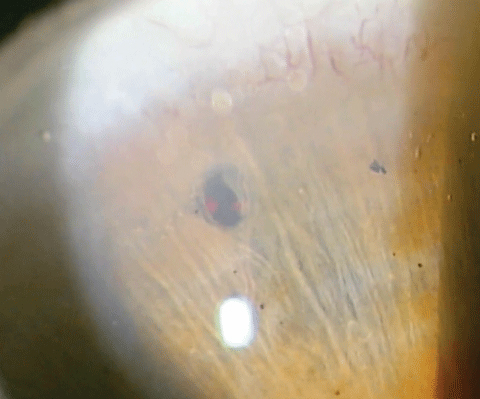 |
|
Researchers found that laser peripheral iridotomy did not reduce incidence of angle closure. Image courtesy of Nathan Lighthizer, OD. Click image to enlarge. |
Knowledge of the natural history of primary angle-closure (PAC) suspects and the effects of laser peripheral iridotomy (LPI), the current standard of care, would offer significant guidance in public health strategy as well as individual management decisions. Considering the large number of PAC suspects in China and the significance of angle closure as a public health problem, a team of researchers in Beijing conducted a randomized trial investigating the progression rate to PAC following LPI in PAC suspects. They found that after one year, LPI did not significantly reduce the incidence of angle closure and that two-thirds of the cohort continued to have non-visibility of the trabecular meshwork for over 180º, possibly due to non-pupillary block mechanisms of angle closure.
The team defined PAC eyes as having non-visibility of the posterior trabecular meshwork for ≥180º on gonioscopy that were randomly assigned to undergo LPI in one eye. All cases classified as progressing to PAC were based on an IOP >21mm Hg. On 134 bilateral PAC suspects, they performed gonioscopy and Goldmann applanation tonometry prior to LPI and seven days, one month and 12 months after LPI. Only 59.7% of patients could be followed up at one year.
The study did not observe significant IOP reduction following LPI at any of the follow-up visits, did not find an association between IOP and the number of non-visible quadrants and found the change in IOP was similar to the fellow 134 untreated eyes. The mean IOP in treated eyes was 15.9mm Hg at baseline and 15.4mm Hg on day seven, 16.5mm Hg at one month and 15.5mm Hg at 12 months. One or more quadrants of the angle opened in 93.7% of the LPI-treated eyes, but 67.0% remained closed in two or more quadrants and 17.8% did not open in three quadrants or more.
The progression rate to PAC in untreated eyes was 3.75%, and one case developed acute angle-closure glaucoma. The progression rate to PAC in treated eyes was 2.5%, and no patients in this cohort developed peripheral anterior synechia or acute angle-closure glaucoma.
“Further longitudinal studies may help better clarify the role of LPI and the implications of residual closure on the need for follow-up and treatment,” the researchers concluded.
Mou DP, Liang YB, Fan SJ, et al. Progression rate to primary angle closure following laser peripheral iridotomy in primary angle-closure suspects: a randomized study. Int J Ophthalmol. 2021;14(8):1179-84. |

